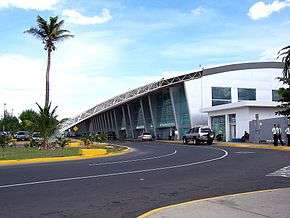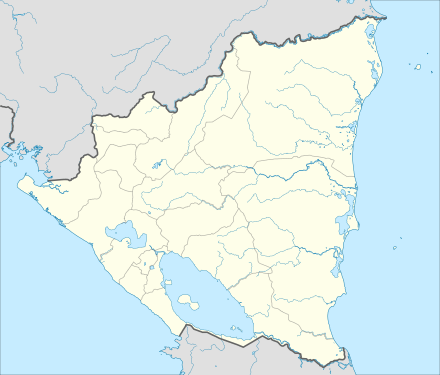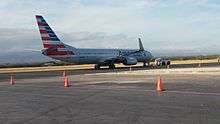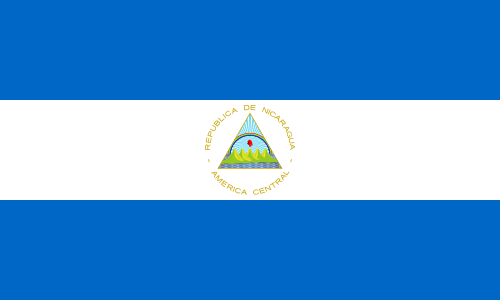Augusto C. Sandino International Airport
Augusto C. Sandino International Airport (Spanish: Aeropuerto Internacional Augusto C. Sandino) (IATA: MGA, ICAO: MNMG) or ACS is the main joint civil-military public international airport in Managua, Nicaragua named after Nicaraguan revolutionary Augusto Nicolás Sandino and located in the City's 6th ward, known locally as Distrito 6. Originally christened as Las Mercedes Airport in 1968, it was later renamed Augusto C. Sandino International Airport during the Sandinista government in the 1980s and again in 2001 to Managua International Airport by then-president Arnoldo Alemán. Its name was changed once more in February 2007 to its current name by President Daniel Ortega to honor the revolutionary.[3] Managua also has an alternative landing strip at Punta Huete Airport. Punta Huete was designed for larger aircraft. This alternative landing site, however, does not service commercial aircraft. The airport is managed by the state-run Administrative Company of International Airports, more commonly known as the EAAI given its Spanish name, the Empresa Administradora de Aeropuertos Internacionales.
Augusto C. Sandino International Airport Aeropuerto Internacional Augusto C. Sandino | |||||||||||
|---|---|---|---|---|---|---|---|---|---|---|---|
 | |||||||||||
| Summary | |||||||||||
| Airport type | Military/Public | ||||||||||
| Owner | Republica de Nicaragua | ||||||||||
| Operator | EAAI (Empresa Administradora de Aeropuertos Internacionales) | ||||||||||
| Serves | Managua | ||||||||||
| Location | Managua, Nicaragua | ||||||||||
| Elevation AMSL | 59 m / 194 ft | ||||||||||
| Coordinates | 12°08′29″N 086°10′05″W | ||||||||||
| Website | www managuaairportnicaragua | ||||||||||
| Map | |||||||||||
 MGA | |||||||||||
| Runways | |||||||||||
| |||||||||||
| Statistics (2017) | |||||||||||
| |||||||||||
The runway at the airport is 8,012 ft long, and it is located at an elevation of 194 feet. With 1.4 million passengers in 2013, ACS is currently the fifth busiest airport by passenger traffic in Central America. Augusto C. Sandino International Airport has direct scheduled service to destinations in the United States, Canada, Mexico, Central America and South America.
History
Before ACS, there was the old Xolotlan Airport, about 2 miles east of Managua, built in 1915 which very soon became too small for Managua's airline service growth. Thus, on January 22, 1942, the Nicaraguan Government and Pan American Airways signed a contract to construct an airport by Las Mercedes Country Estate which inspired the name for Las Mercedes Airport.[4] Las Mercedes was further upgraded, re-designed to handle Boeing 707 aircraft, and re-inaugurated on July 4, 1968, by Anastasio Somoza Debayle.[5]
In the early 1970s, Las Mercedes was expanded to more modern standards, such as four health inspectors, eight immigration officers and ten customs inspectors.[6] It was considered fully equipped, having air conditioning, background music, loudspeakers and conveyor belts for baggage handling.[7] It also had a restaurant on its upper floor where visitors and travelers could see airport movement.
The expanded airport could serve three aircraft at once and by 1975 LANICA, the National Airline of Nicaragua, as well as many well known carriers Pan Am, KLM (Royal Dutch Airlines), Taca Airlines, Sahsa, Avianca, Iberia, SAM, TAN, Varig, and smaller local carriers, flew into Las Mercedes. When the Sandinistas took power, the airport was named after Augusto César Sandino, a Nicaraguan revolutionary and guerrilla leader, after whom the Sandinista movement is named. The Sandinistas however did not maintain the airport, and it began to deteriorate until it was expanded and remodeled in 1996, when, among other things, two new boarding bridges were installed.[6] The airport was renamed "Managua International Airport" in 2001 by then President Arnoldo Alemán and renamed again in 2007 to its current name by President Daniel Ortega In mid 2007, President Daniel Ortega renamed the airport in honor of Sandino. Nicaraguan artist Róger Pérez de la Rocha has created two large portraits of Augusto César Sandino, and Rubén Darío which they lay at the airports lobby.[8]
Las Mercedes served for a very long time as a hub for Nicaragua's flag carriers Lanica (until 1978), Aeronica from 1979 to the 80's and NICA afterwards. When NICA became a member of Grupo TACA during the 1990s, the number of important connections to the rest of Latin America from which ACS grew considerably.
According to EAAI (Empresa Administradora de Aeropuertos Internacionales) ACS is the most modern airport in Central America and the 4th safest in the world. It is located just 11 km (7 mi) from Managua's downtown, has a runway which measures 8,015 ft (2,443 m) in length and is at an elevation of 194 ft (59 m).[9]
Embraer 190s, Airbus A300, Airbus A310, Airbus A320, Airbus A330, Airbus 340 Boeing 737s, Boeing 747s, Boeing 757s, Boeing 767s, Lockheed L-1011 TriStars and McDonnell Douglas DC-10s can land at the airport.
Expansion
A large expansion programme was underway by 2003 and as of July 2006 the final phase was completed with 7 gates equipped with jetways, and room for 20 airplanes to park. It had been reported in the recent past that the runway would be lengthened by 800 m (2,625 ft), but to date this projected has not begun, despite the government's great achievements in building new airports elsewhere in Nicaragua, or greatly overhauling existing airport/airfield infrastructure in other locations as well.[10]
About 360 individuals are employed at the airport. Facilities within the airport include a tourist information desk, bank, restaurants, bars, post office, souvenir shops, duty-free shops, lounges and more. To make use of the VIP lounge there are five rate options: Normal, Corporate, Affiliated Credit Cards, Minors and Infants. The types of services in the VIP lounge include checking baggage and documents with customs and immigration plus the airline; a bar service; snacks etc.[11]
Operations
Augusto C. Sandino International Airport is Nicaragua's main international gateway. Domestic flights fly between Bluefields and the Corn Islands airports while also serving a number of airstrips to the country's east. The airport is accessed by the Panamerican Highway, known as the Carretera Norte. The airport serves as the hub for Avianca Nicaragua.
Airlines and destinations
Passenger
| Airlines | Destinations |
|---|---|
| Aeroméxico Connect | Mexico City (resumes September 1, 2020)[12] |
| American Airlines | Miami |
| Avianca Costa Rica | San Jose (CR) |
| Avianca El Salvador | Miami, San Salvador (resumes August 20, 2020)[13] |
| Avianca Guatemala | Guatemala City, San Salvador |
| Conviasa | Caracas, Havana, Panama City–Tocumen |
| Copa Airlines | Guatemala City, Panama City–Tocumen (resumes September 4, 2020),[14] San José (CR) |
| Delta Air Lines | Atlanta |
| La Costeña | Bluefields, Bonanza, Corn Island, Emerald Coast, Ometepe, Puerto Cabezas, Rosita, San Carlos, San Juan de Nicaragua (Greytown), Siuna, Tegucigalpa, Waspam Charter: Montelimar Beach |
| Spirit Airlines | Fort Lauderdale |
| United Airlines | Houston–Intercontinental |
Cargo
| Airlines | Destinations |
|---|---|
| Amerijet International | Miami, Panama City–Tocumen, San Pedro Sula |
| LATAM Cargo Colombia | Bogotá, Miami, Panama City–Tocumen |
| UPS Airlines | Miami, Panama City–Tocumen, San Salvador |
Statistics
Traffic figures
.jpg)

| Passengers | Change from previous year | Aircraft operations | Change from previous year | Cargo (metric tons) | Change from previous year | |
|---|---|---|---|---|---|---|
| 2006 | 979,508 | 30,897 | 19,223 | |||
| 2007 | 1,051,830 | 30,609 | 21,727 | |||
| 2008 | 1,138,626 | 31,705 | 19,129 | |||
| 2009 | 1,090,004 | 31,677 | 18,946 | |||
| 2010 | 1,102,196 | 30,030 | 25,981 | |||
| 2011 | 1,120,147 | 28,855 | 22,330 | |||
| 2012 | 1,201,141 | 30,697 | 23,531 | |||
| 2013 | 1,206,172 | 29,955 | 22,281 | |||
| 2014 | 1,311,965 | 29,326 | 23,375 | |||
| 2015 | 1,499,756 | 32,173 | 29,034 | |||
| 2016 | 1,533,034 | 36,822 | 25,383 | |||
| 2017 | 1,627,527 | 36,510 | 25,639 | |||
| Source: Nicaraguan Institute of Civil Aviation. Statistical Reports (Years 2007,[15] 2008,[16] 2009,[17] 2010,[18] 2011,[19] 2012,[20] 2013,[21] 2014,[22] 2015[23] and 2016[24]) | ||||||
Top international destinations
| Airport | 2014 | 2015 | 2016 | Δ 14-15 | Δ 15-16 | Carriers | |
|---|---|---|---|---|---|---|---|
| 1 | Miami, United States | 407,800 | 443,800 | 470,000 | American, Avianca | ||
| 2 | Houston, United States | 172,400 | 211,400 | 194,000 | Spirit, United | ||
| 3 | Panama City, Panama | 174,000 | 196,600 | 197,700 | Copa | ||
| 4 | San Salvador, El Salvador | 165,600 | 175,900 | 145,000 | Avianca, Volaris | ||
| 5 | San José, Costa Rica | 78,500 | 79,900 | 100,000 | Avianca, Copa, Volaris | ||
| 6 | Atlanta, United States | 87,100 | 96,500 | 97,000 | Delta | ||
| 7 | Guatemala City, Guatemala | 42,500 | 52,800 | 86,000 | Avianca, Copa | ||
| 8 | Mexico City, Mexico | 3,500 | 45,700 | 52,000 | Aeroméxico Connect | ||
| Source: Ministry of Transport and Infrastructure (MTI). Transportation Statistical Yearbook of Nicaragua (Years 2014,[22] 2015[23] and 2016[24]). | |||||||
Traffic Share of Airlines flying to MGA
| Airline | Percentage of Passengers Transported (2015) |
| 31% | |
| 20% | |
| 15% | |
| 14% | |
| 7% | |
| 6% | |
| 3% | |
| 2% | |
| 1% | |
| 1% | |
| 1% | |
| Total | 100.0% |
See also


- List of airports in Nicaragua
- Transport in Nicaragua
References
- (in Spanish)Publicación de Información Aeronáutica de la República de Nicaragua Archived 2016-11-12 at the Wayback Machine
- (in Spanish) Anuario Estadístico de Transporte de Nicaragua 2016 Archived 2017-10-11 at the Wayback Machine
- Velásquez SevillaMi, Mirna. "Aeropuerto vuelve a ser Sandino". La Prensa (in Spanish). Archived from the original on September 27, 2007. Retrieved October 17, 2007.
- "Aeropuerto Internacional "Augusto C. Sandino"" (PDF) (in Spanish). EAAI. p. 2. Archived from the original (PDF) on June 26, 2007. Retrieved February 14, 2008.
- Westcott, Kathryn (May 22, 2006). "Flying from where?; Cultural Heritage". BBC News. Archived from the original on October 11, 2007. Retrieved October 17, 2007.
- "History". EAAI. Archived from the original on August 10, 2007. Retrieved October 17, 2007.
- "Managua International Airport". Airplanes.com. Archived from the original on October 12, 2007. Retrieved October 17, 2007.
- "Cultural" Archived 2014-04-09 at the Wayback Machine, El Nuevo Diario, 19 February 2000
- "Technical Information". EAAI. Archived from the original on August 8, 2007. Retrieved October 17, 2007.
- "Projects in Progress". EAAI. Archived from the original on August 8, 2007. Retrieved October 17, 2007.
- "VIP Lounge". EAAI. Archived from the original on August 9, 2007. Retrieved October 17, 2007.
- "Safety Precautions: COVID-19". Aeroméxico. July 2020. Retrieved July 19, 2020.
- "Avianca reviews the restart of its flights in Central America". Nicolás Larenas (in Spanish). August 2020. Retrieved August 8, 2020.
- "Copa Airlines would restart its flights to these international destinations". Nicolás Larenas (in Spanish). July 2020. Retrieved August 4, 2020.
- Anuario Estadistico 2007 Archived 2016-11-12 at the Wayback Machine. Instituto Nicaragüense de Aeronáutica Civil
- Anuario Estadistico 2008 Archived 2016-11-12 at the Wayback Machine. Instituto Nicaragüense de Aeronáutica Civil
- Anuario Estadistico 2009 Archived 2017-03-05 at the Wayback Machine. Instituto Nicaragüense de Aeronáutica Civil
- Anuario Estadistico 2010 Archived 2016-11-12 at the Wayback Machine. Instituto Nicaragüense de Aeronáutica Civil
- Anuario Estadistico 2011 Archived 2016-11-12 at the Wayback Machine. Instituto Nicaragüense de Aeronáutica Civil
- Anuario Estadistico 2012 Archived 2016-11-12 at the Wayback Machine. Instituto Nicaragüense de Aeronáutica Civil
- Anuario Estadistico 2013 Archived 2016-11-12 at the Wayback Machine. Instituto Nicaragüense de Aeronáutica Civil
- Anuario Estadístico de Transporte de Nicaragua 2014 Archived 2019-08-06 at the Wayback Machine. Ministerio de Transporte e Infraestructura (MTI)
- Anuario Estadístico de Transporte de Nicaragua 2015 Archived 2019-04-13 at the Wayback Machine. Ministerio de Transporte e Infraestructura (MTI)
- Anuario Estadístico de Transporte de Nicaragua 2016 Archived 2017-10-11 at the Wayback Machine. Ministerio de Transporte e Infraestructura (MTI)